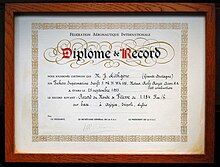Michael John Lithgow, OBE (30 August 1920 – 22 October 1963) was a British aviator and chief test pilot for Vickers Supermarine who became the holder of the World Absolute Air Speed Record in 1953 flying a Supermarine Swift. He died when the prototype BAC One-Eleven airliner crashed in 1963.
Early life
Mike Lithgow was born on 30 August 1920 and educated at Cheltenham College.[1]
Second World War
Lithgow was a member of the Fleet Air Arm from March 1939 – December 1945. As a Lieutenant Commander on HMS Ark Royal, he flew Swordfish torpedo bombers and was one of the pilots attacking the Bismarck.[2][better source needed]
Test pilot

He retired from the Navy and moved to Vickers Supermarine as a test pilot in January 1946 and became the company's chief test pilot two years later.
In September 1946, he took part in the Lympne high speed air race, flying a Supermarine Seafang, competing against Bill Humble in a Hawker Fury, Geoffrey de Havilland in a D.H. Vampire and G.H Pike in a D.H. Hornet[3]
On 26 September 1953, flying the Supermarine Swift F.4 prototype, WK198, Lithgow broke the World Air Speed Record near Tripoli in Libya, reaching a speed of 735.7 mph (1184 km/h). He was awarded the Gold Medal of the Royal Aero Club and the Geoffrey de Havilland Trophy in 1953[4]
He did extensive test flying on the Supermarine Attacker, Swift, Scimitar and later the Vickers Vanguard and BAC 1–11.[4]
Lithgow died test flying the prototype BAC One-Eleven G-ASHG from Wisley airfield on 22 October 1963 when during stall tests the aircraft entered a deep stall and crashed near Chicklade, Wiltshire. Six other BAC flight test team members were also killed.[5]
References
Citations
- ^ Skinner (2025), p. 86.
- ^ family history
- ^ Flight (1946), p. 236.
- ^ a b Flight International (1963), p. 709.
- ^ Flight International (1963), p. 708.
Sources
- Autobiography: Mach One. (Oct 1954). Allan Wingate Ltd. ASIN: B0000CIZSW
- Editor: Vapour Trails. (1956). Allan Wingate Ltd. ASIN: B0000CJFFQ
- Skinner, Stephen (March 2025). "A Very British Hero". Aeroplane. Vol. 53, no. 3. pp. 84–93. ISSN 0143-7240.
- "World News: The One-Eleven Accident". Flight International. 31 October 1963. pp. 708–709. Archived from the original on 8 October 2014.
- "World's Fastest Air Race". Flight. 5 September 1946. p. 236. Archived from the original on 3 February 2017.
External links









You must be logged in to post a comment.